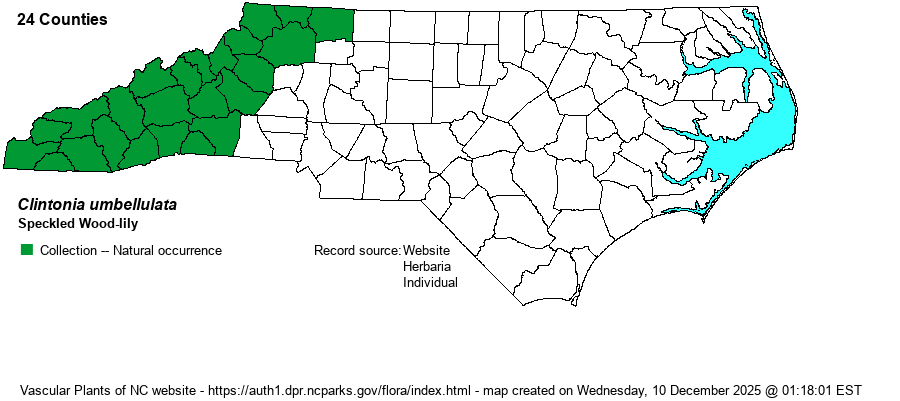| Author | (Michaux) Morong | |
| Distribution | Occurs across the entire Mountains region, with records for all counties. Ranges into the higher edges of the Piedmont but is not found on outlier ranges and monadnocks.
Unlike the similar C. borealis, this species is limited essentially to the Appalachian Mountains and outlier ranges to the west. It ranges from western NY and central OH southward to northwestern SC, northern GA, and eastern TN. | |
| Abundance | Common and widespread in the middle elevations of the Mountains, mainly from about 3,000 feet to about 5,500 feet, being most common perhaps from about 3,500 feet to 5,000 feet in elevation. | |
| Habitat | This is a species of fairly cool and mesic shaded forests, of a variety of types. It is most common in various oak forests at mid-elevations, as well as in Acidic Cove Forests, less often in Northern Hardwood Forests or Rich Cove Forests. It favors more acidic soils than many other lilies and can often be found in the company of evergreen rhododendrons and other heath species. | |
| Phenology | Blooms from mid-May through June; fruits from August to October. | |
| Identification | This is one of several species with large, elliptical, glossy parallel-veined leaves growing in a rosette. It has several (often 3) rather long leaves, each about 8-9 inches long and about 2 inches wide. The naked flower stalk reaches about 10 inches high, and it is topped by 10-25 white flowers. The 6 white tepals are widely spreading such that each flower is about 2/3-inch across; there are usually a few dark "speckles" on the tepals, giving rise to the most frequent common name. About two months later, the stalk is topped by blackish berries. The species is completely unmistakable when in bloom, as the similar C. borealis has yellowish flowers that are larger, as well as blue berries. However, as you will certainly encounter large numbers of one or both species on spring walks at middle to high elevations, you may have to use leaf characters for identifications, as both do not flower until well into May. This species has leaves that have margins strongly hairy, especially near the base. C. borealis leaves are nearly glabrous and with only slightly ciliated margins. This can be one of the most common herbaceous species you will see in some of the drier or less rich hardwood forests at middle elevations, especially as it often grows in large colonies. Note that C. borealis tends to grow mostly over 5,000 feet, though both can grow together. | |
| Taxonomic Comments | None
| |
| Other Common Name(s) | White Clintonia, Clinton's Lily (a poor name, as it is also used for Clintonia borealis) | |
| State Rank | S5 | |
| Global Rank | G5 | |
| State Status | | |
| US Status | | |
| USACE-agcp | | |
| USACE-emp | | |

